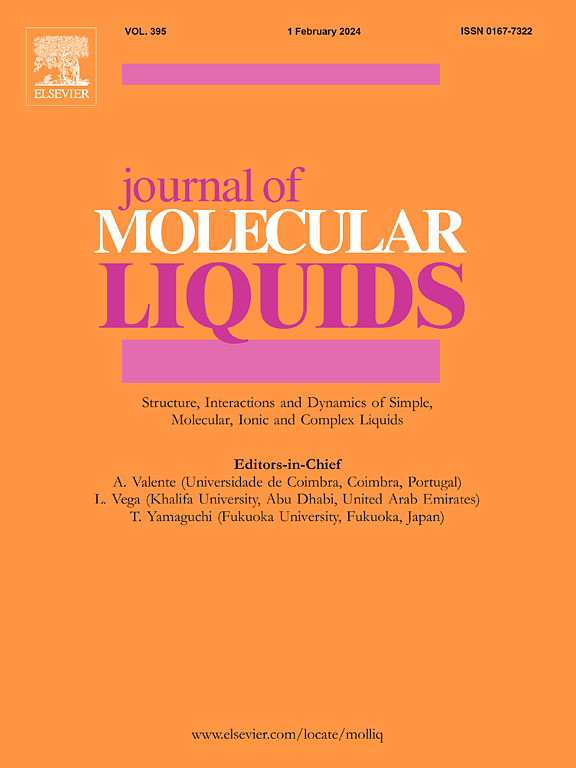浓度和溶剂调制分子间费米共振
IF 5.3
2区 化学
Q2 CHEMISTRY, PHYSICAL
引用次数: 0
摘要
本研究将氩基隔离、退火控制聚集和偏振拉曼光谱相结合,解决了长期以来关于环戊酮中CO拉伸振动分裂起源的争议。首次在ppm浓度下分离出环戊酮单体,揭示了单个CO峰,并排除了单个分子中的费米共振。控制退火跟踪原位二聚体的形成,揭示了四重态分裂模式(1749/1750和1732/1734 cm−1)作为分子间偶极子耦合和费米共振激活的光谱特征。溶剂特异性调制被证实:非质子溶剂(CCl4, CH3CN)诱导浓度依赖的蓝移,而质子CH3OH形成氢键团簇抑制共振,基质分离证实在70 K以下没有分子间相互作用。实现了光驱动聚合控制,其中365 nm照射选择性地通过二聚化增强共振,而254/405 nm光抑制共振。在DFT计算的支持下,本研究重新定义了费米共振的机制框架,建立了一种通过环境和光调制来探测分子间动力学和设计可调谐光电材料的通用策略。本文章由计算机程序翻译,如有差异,请以英文原文为准。
Concentration and solvent modulated intermolecular Fermi resonance
This study resolves the long-standing controversy over the origin of C![]() O stretching vibration splitting in cyclopentanone by integrating argon matrix isolation, annealing-controlled aggregation, and polarized Raman spectroscopy. For the first time, cyclopentanone monomers were isolated at ppm concentrations, revealing single C
O stretching vibration splitting in cyclopentanone by integrating argon matrix isolation, annealing-controlled aggregation, and polarized Raman spectroscopy. For the first time, cyclopentanone monomers were isolated at ppm concentrations, revealing single C![]() O peaks and excluding Fermi resonance in individual molecules. Controlled annealing tracked dimer formation in situ, unveiling a quadruplet splitting pattern (1749/1750 and 1732/1734 cm−1) as a spectroscopic signature of intermolecular dipole coupling and Fermi resonance activation. Solvent-specific modulation was demonstrated: aprotic solvents (CCl4, CH3CN) induced concentration-dependent blueshifts, while protic CH3OH formed hydrogen-bonded clusters that suppressed resonance, with matrix isolation confirming no intermolecular interaction below 70 K. Light-driven aggregation control was achieved, where 365 nm irradiation selectively enhanced resonance through dimerization, whereas 254/405 nm light suppressed it. Supported by DFT calculations, this work redefines the mechanistic framework of Fermi resonance, establishing a universal strategy for probing intermolecular dynamics and designing tunable optoelectronic materials through environmental and optical modulation.
O peaks and excluding Fermi resonance in individual molecules. Controlled annealing tracked dimer formation in situ, unveiling a quadruplet splitting pattern (1749/1750 and 1732/1734 cm−1) as a spectroscopic signature of intermolecular dipole coupling and Fermi resonance activation. Solvent-specific modulation was demonstrated: aprotic solvents (CCl4, CH3CN) induced concentration-dependent blueshifts, while protic CH3OH formed hydrogen-bonded clusters that suppressed resonance, with matrix isolation confirming no intermolecular interaction below 70 K. Light-driven aggregation control was achieved, where 365 nm irradiation selectively enhanced resonance through dimerization, whereas 254/405 nm light suppressed it. Supported by DFT calculations, this work redefines the mechanistic framework of Fermi resonance, establishing a universal strategy for probing intermolecular dynamics and designing tunable optoelectronic materials through environmental and optical modulation.
求助全文
通过发布文献求助,成功后即可免费获取论文全文。
去求助
来源期刊

Journal of Molecular Liquids
化学-物理:原子、分子和化学物理
CiteScore
10.30
自引率
16.70%
发文量
2597
审稿时长
78 days
期刊介绍:
The journal includes papers in the following areas:
– Simple organic liquids and mixtures
– Ionic liquids
– Surfactant solutions (including micelles and vesicles) and liquid interfaces
– Colloidal solutions and nanoparticles
– Thermotropic and lyotropic liquid crystals
– Ferrofluids
– Water, aqueous solutions and other hydrogen-bonded liquids
– Lubricants, polymer solutions and melts
– Molten metals and salts
– Phase transitions and critical phenomena in liquids and confined fluids
– Self assembly in complex liquids.– Biomolecules in solution
The emphasis is on the molecular (or microscopic) understanding of particular liquids or liquid systems, especially concerning structure, dynamics and intermolecular forces. The experimental techniques used may include:
– Conventional spectroscopy (mid-IR and far-IR, Raman, NMR, etc.)
– Non-linear optics and time resolved spectroscopy (psec, fsec, asec, ISRS, etc.)
– Light scattering (Rayleigh, Brillouin, PCS, etc.)
– Dielectric relaxation
– X-ray and neutron scattering and diffraction.
Experimental studies, computer simulations (MD or MC) and analytical theory will be considered for publication; papers just reporting experimental results that do not contribute to the understanding of the fundamentals of molecular and ionic liquids will not be accepted. Only papers of a non-routine nature and advancing the field will be considered for publication.
 求助内容:
求助内容: 应助结果提醒方式:
应助结果提醒方式:


